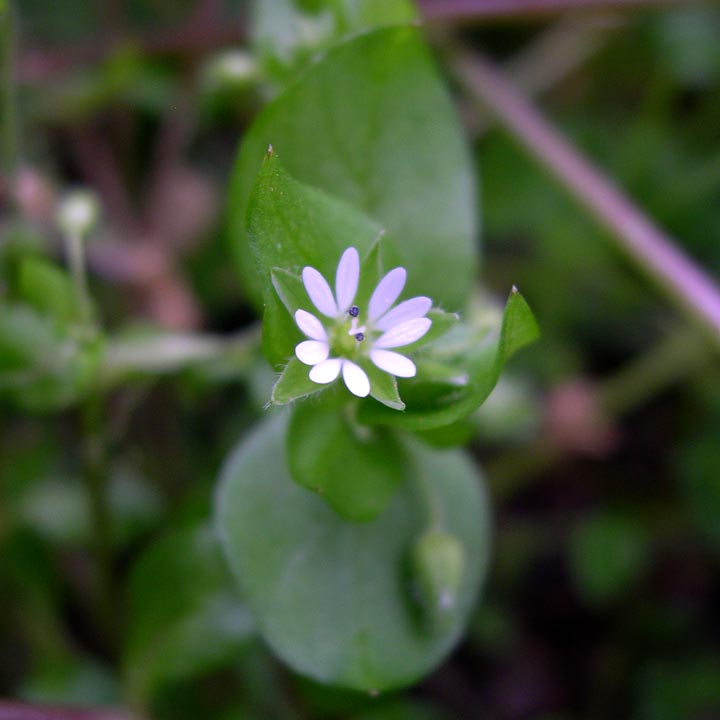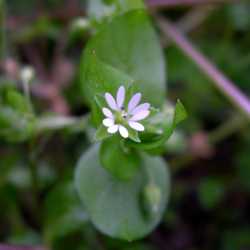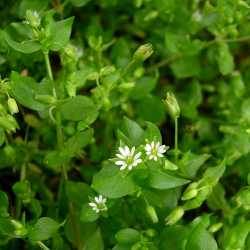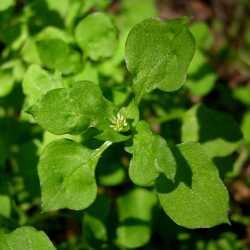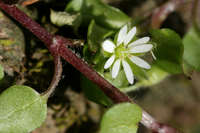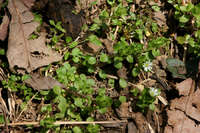Plants annual or winter annual, green, with slender taproot. Stems decumbent or ascending, diffusely branched, 4-sided, 5-40 cm, with single line of hairs along each internode. Leaves petiolate (proximal) or ± sessile (distal); blade usually green, ovate to broadly elliptic, 0.5-4 cm × 2-20 mm, base round to cuneate, margins entire, apex acute or shortly acuminate, ± glabrous or ciliate at base. Inflorescences terminal, 5-many-flowered cymes; bracts ovate and shortly acuminate to lanceolate-acute, 1-40 mm, herbaceous. Pedicels ascending, usually straight, deflexed at base in fruit, 3-40 mm, usually with line of hairs. Flowers 2-5 mm diam.; sepals 5, with obscure midrib, ovate-lanceolate, 4.5-5(-6) mm, margins narrow, scarious, apex obtuse, usually glandular-hairy; petals absent or 5, 1-4 mm, shorter than to equaling sepals; stamens 3-5(-8); anthers red-violet; styles 3, outwardly curved, becoming curled, 0.5-1 mm. Capsules green to straw colored, ovoid-oblong, 3-5 mm, somewhat longer than sepals, apex obtuse, opening by 6 valves; carpophore absent. Seeds reddish brown, broadly reniform to round, 0.9-1.3 mm diam., with obtuse, round, or flat-topped (broader than tall) tubercles. 2n = 40, 42, 44.
Flowering year-round where climatic conditions permit. Cultivated ground, waste places, open woodlands; 0-2500 m; introduced; Greenland; St. Pierre and Miquelon; Alta., B.C., Man., N.B., Nfld. and Labr., N.W.T., N.S., Ont., P.E.I., Que., Sask., Yukon; Ala., Alaska, Ariz., Ark., Calif., Colo., Conn., Del., D.C., Fla., Ga., Idaho, Ill., Ind., Iowa, Kans., Ky., La., Maine, Md., Mass., Mich., Minn., Miss., Mo., Mont., Nebr., Nev., N.H., N.J., N.Mex., N.Y., N.C., N.Dak., Ohio, Okla., Oreg., Pa., R.I., S.C., S.Dak., Tenn., Tex., Utah, Vt., Va., Wash., W.Va., Wis., Wyo.; Europe.
Stellaria media, now a cosmopolitan weed, is a very polymorphic species, varying in size, habit, pubescence, petal length, stamen number, and seed size and surface detail.
The Stellaria media complex consists of three very similar and closely related species, S. media, S. neglecta, and S. pallida. They can almost always be distinguished by the characters given in the key, but in a few doubtful cases a chromosome count is desirable for positive identification. The problem arises from the considerable phenotypic variation which is displayed by S. media, and to a lesser extent by S. pallida. There is no evidence for gene exchange between these species. Stellaria pallida is autogamous and sometimes cleistogamous; S. media is both autogamous and occasionally cross-pollinated by flies; S. neglecta is usually cross-pollinated by flies but is self-compatible.
Annual herb with a slender taproot 5 - 40 cm tall
Stem: ascending or decumbent, widely branched, four-angled, weak, hairy in a single line along each internode.
Leaves: opposite, stalked (lower), more or less stalkless (upper), 0.5 - 4 cm long, 2 mm - 2 cm wide, egg-shaped to broadly elliptic with a rounded to wedge-shaped base and pointed tip, one-veined, more or less hairless, sometimes with a marginal fringe of hairs at the base.
Inflorescence: a terminal, leafy cluster (cyme) of five to many flowers (sometimes one), subtended by a pair of bracts. Bracts 1 mm - 4 cm long, egg-shaped with a more or less pointed tip, herbaceous.
Flowers: white, 2 - 5 mm wide. Stalk ascending, usually straight, 3 mm - 4 cm long, usually with a line of hairs. Stamens usually three to five. Anthers reddish violet. Styles three.
Sepals: five, distinct, green, 3.5 - 6 mm long, egg- lance-shaped with a more or less blunt tip, scarious-margined (dry, thin, and membranous), glandular-hairy.
Petals: five or none, white, 1 - 4 mm long, shorter than or equal to the sepals, deeply two-lobed (giving the appearance of ten petals).
Fruit: a dehiscent capsule, opening by six valves, green to straw-colored, 3 - 5 mm long, slightly longer than sepals, oblong egg-shaped with a blunt apex. Seeds reddish brown, 0.9 - 1.2 mm long, round to broadly kidney-shaped, laterally compressed, bluntly bumpy (margin looks wavy).
Similar species: The very similar Stellaria pallida differs by its yellowish green foliage, smaller size, and smaller sepals and seeds.
Flowering: late February to early November
Habitat and ecology: Introduced from Eurasia. Common as a weed in gardens, truck farms, highly fertilized nursery plots, and lawns. Often found in areas where shade has reduced competition. Occasionally found in less-competitive areas of wooded floodplains.
Occurence in the Chicago region: non-native
Notes: This weed can be quite variable in size, habit, hairiness, petal length, stamen count, and seed size.
Etymology: Stellaria comes from the Latin words stella, meaning star, and -aria meaning "pertaining to," referring to the shape of the flowers. Media means middle or average.
Author: The Morton Arboretum
Found throughout the state and reported from many counties. It is an annoying weed in lawns and in all kinds of cultivated ground, especially about habitations. My specimens, however, with a few exceptions, are from the woodland where it sometimes appears as native. It is occasional to frequent in woodland, especially in the alluvial bottoms. The species is extremely variable and our specimens might be assigned varietal names as is done by some authors, but I doubt whether they are of taxonomic value. It is to be expected that a cosmopolitan species with widely varying habitats would show conspicuous variations.
Duration: Annual
Nativity: Non-Native
Lifeform: Forb/Herb
General: Annual with slender taproot, decumbent or ascending, diffusely branched, 5-40 cm, with a single line of hairs along each internode.
Leaves: Opposite, petiolate or sessile, blade ovate to broadly elliptic, 0.5-4 cm long by 2-20 mm wide, base round to cuneate, entire margins, acute or shortly acuminate apex, and glabrous or ciliate at base.
Flowers: Terminal 5-many flowered cymes, bracts ovate and shortly acuminate to lanceolate-acute, 1-40 mm, herbaceous; ascending pedicels, 3-40, usually with line of hairs; flowers 2-5 mm in diameter; 5 sepals with obscure midrib, ovate-lanceolate, 4.5-5 mm, narrow margins, scarious, obtuse apex, usually glandular-hairy; petals absent or 5, 1-4 mm, shorter than or equaling sepals; 3-5 stamens, red-violet anthers, 3 styles, becoming curled, 0.5-1 mm.
Fruits: Ovoid capsule, green to straw colored 3-5 mm long, obtuse apex, opening by 6 valves.
Ecology: Found in disturbed areas, cultivated ground, open woodlands, and waste places from sea level to 8,500 ft (2591 m); flowers February-April, but flowers year round where climate permits.
Notes: A very cosmopolitan weed, having become polymorphic over time, tends to vary quite widely.
Ethnobotany: Used as an eye wash, as an antirheumatic and for swellings, it is applied to cuts and wounds, and it is fed to chickens as forage.
Etymology: Stellaria is from the Latin stella for star for the flower shape, while media means the middle.
Synonyms: None
Editor: SBuckley, 2010
Annual, the weak, branched stems to 4 dm, puberulent in 1 or 2 broad lines; lvs mostly 1-3 cm, ovate to obovate, the upper sessile, the lower with progressively longer petiole, often ciliate toward the base or on the petiole, otherwise mostly glabrous; fls solitary or in small, terminal, leafy cymes; sep lance-oblong, 3.5-6 mm, obtuse or acutish, ±hairy and pustulate; pet shorter than the sep; stamens 3-5(10); fr ovoid, usually deflexed; seeds 0.9-1.2 mm, suborbicular, bluntly papillate, so that the margin looks wavy; 2n mostly=40-44. A highly variable weed of waste places, cult. areas, meadows, and woodlands, intr. from the Old World, but sometimes appearing like a native. Early spring-late fall. (Alsine m.)
Gleason, Henry A. & Cronquist, Arthur J. 1991. Manual of vascular plants of northeastern United States and adjacent Canada. lxxv + 910 pp.
©The New York Botanical Garden. All rights reserved. Used by permission.


